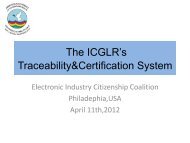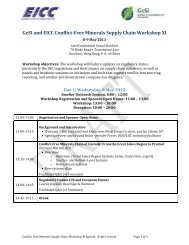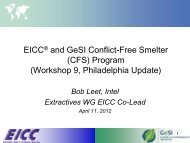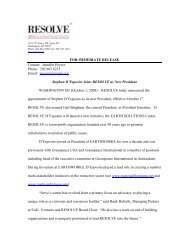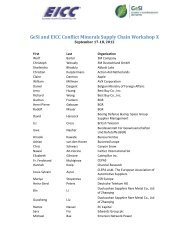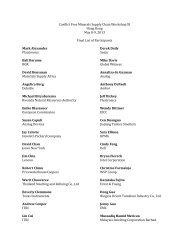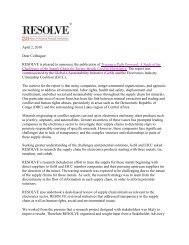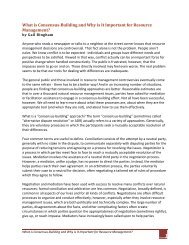Toward SuSTainabiliTy: The roleS and limiTaTionS of ... - Resolve
Toward SuSTainabiliTy: The roleS and limiTaTionS of ... - Resolve
Toward SuSTainabiliTy: The roleS and limiTaTionS of ... - Resolve
Create successful ePaper yourself
Turn your PDF publications into a flip-book with our unique Google optimized e-Paper software.
Chapter 1: Setting the Context 16the integrity <strong>and</strong> credibility <strong>of</strong> voluntary st<strong>and</strong>ards<strong>and</strong> certification. 21In the auditing <strong>of</strong> social <strong>and</strong> environmental performance,it is usually not sufficient that auditorshave completed the required training courses,have the requisite knowledge about the st<strong>and</strong>ard<strong>and</strong> the sector, <strong>and</strong> know how to carry out anaudit; auditors also need skills in stakeholder consultation<strong>and</strong> interviewing. Certification bodiesare <strong>of</strong>ten able to identify early on who will makea good auditor based on the “s<strong>of</strong>t” skills that theindividual possesses. <strong>The</strong>se personal attributescan make the difference between a good auditor<strong>and</strong> a great one. 22Among the key challenges faced by st<strong>and</strong>ardssystems in ensuring competent auditors is thevariability <strong>of</strong> the contexts to which the st<strong>and</strong>ardis applied. Given that many <strong>of</strong> these st<strong>and</strong>ardsare intended to apply globally but need to takeinto account local social customs <strong>and</strong> norms aswell as ecological realities, it is not surprising thatauditors have a hard time being consistent in theirinterpretations <strong>of</strong> the st<strong>and</strong>ard. This has as muchto do with the process in place to develop localinterpretations <strong>of</strong> st<strong>and</strong>ards as it does with thecompetence <strong>of</strong> auditors.In addition, comparatively few certification bodiesare based in developing countries, where a lot<strong>of</strong> certification takes place. In some cases, thereare not enough auditors who have a good underst<strong>and</strong>ing<strong>of</strong> local social <strong>and</strong> ecological contexts.Another challenge is that the volume <strong>of</strong> work insome countries is quite limited (particularly wherest<strong>and</strong>ards systems have only recently exp<strong>and</strong>ed),so it is difficult to retain qualified auditors. Thus,certification bodies may not invest adequately inauditor training <strong>and</strong> pr<strong>of</strong>essional developmentuntil the quantity <strong>of</strong> work <strong>and</strong> income justifiesthe investment (personal communication, ISEALmembers).A final key issue relating to auditor competenceinvolves integrity <strong>and</strong> conflicts <strong>of</strong> interest. In eventhe most rigorous assurance system, involvingthird-party assessments, auditors may becometoo friendly with their clients, or they may havefinancial incentives for maintaining the certificationstatus <strong>of</strong> the client. Outright fraud <strong>and</strong>corruption, though infrequent, is also a risk.Experts in the field have a relatively good underst<strong>and</strong>ing<strong>of</strong> what is required to ensure thatauditors have both integrity <strong>and</strong> competence.It involves identifying individuals with the rightcombination <strong>of</strong> skills, knowledge, <strong>and</strong> personalattributes <strong>and</strong> supporting them with adequatetraining, pr<strong>of</strong>essional development, oversight,<strong>and</strong> work. <strong>The</strong> challenge lies in transforming thisvision to reality. Most st<strong>and</strong>ards systems do nothave the economies <strong>of</strong> scale to support auditorsin these ways, as it can be prohibitively expensive.It may be useful for st<strong>and</strong>ards systems to exploreopportunities for coordination, such as the delivery<strong>of</strong> joint training programs or shared auditorregistration, which starts to get at the efficienciesthat scale can bring (personal communication,ISEAL members).Governance ChallengesStakeholder engagement is a core tenet in manysocial <strong>and</strong> environmental st<strong>and</strong>ards systems, withstakeholders playing central roles in st<strong>and</strong>ardsdevelopment <strong>and</strong> governance. While this driveslegitimacy (Cashore, 2002) <strong>and</strong> buy-in, it can alsomake the st<strong>and</strong>ards system bureaucratic <strong>and</strong> slowto respond (Cashore, et al., 2004).St<strong>and</strong>ards systemshave been accused <strong>of</strong> not being responsiveto changing market needs <strong>and</strong>, more importantly,have seen other sustainability tools innovate <strong>and</strong>evolve faster to meet changing expectations.<strong>The</strong> challenge for st<strong>and</strong>ards systems is that theyare required to combine stakeholder-driven processessuch as st<strong>and</strong>ard setting with operatinga business. <strong>The</strong> limitations <strong>of</strong> this model arisewhen stakeholders put their own interests firstin considering decisions related to the running21 www.isealalliance.org/online-community/resources/background-research-for-the-assurance-code-project22 Ibid.<strong>Toward</strong> Sustainability: <strong>The</strong> Roles <strong>and</strong> Limitations <strong>of</strong> Certification



